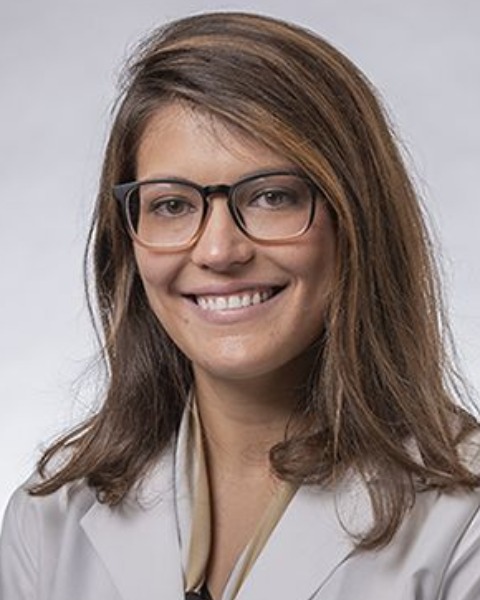Back
Public Health & Prevention
Category: Abstract Submission
Public Health & Prevention I
569 - SARS-CoV-2 transmission patterns in a medical summer camp
Saturday, April 23, 2022
3:30 PM – 6:00 PM US MT
Poster Number: 569
Publication Number: 569.240
Publication Number: 569.240
Kristy M. Wilkinson, Albany Medical Center, Albany, NY, United States; Stephanie Neaton, Albany Medical College, Albany, NY, United States; Erik L. Reidel, Albany Medical College, Albany, NY, United States; Ashar Ata, Albany Medical College, Albany, NY, United States; Christopher Woll, Albany Medical College, Albany, NY, United States

Kristy M. Wilkinson, MD, BA
Resident Physician, PGY-2
Albany Medical Center
Albany, New York, United States
Presenting Author(s)
Background: Most children with chronic or life-threatening medical conditions do not get the chance to experience camp but do have the opportunity to participate in medically oriented summer camps. SARS-CoV-2, the viral cause of the COVID-19 pandemic, poses unique challenges in the safe deliverance of a camp experience in a population that is vulnerable to severe disease from SARS-CoV-2. Multiple studies have looked at non-pharmaceutical interventions (NPIs) for preventing SARS-CoV-2 transmission in traditional summer camp settings, but none in the medical summer camp setting.
Objective: Our objective was to describe the NPIs and SARS-CoV-2 transmission rate in a medical summer camp setting.
Design/Methods: This was a single institution cross sectional study conducted between June and August 2021 in a rural residential medical summer camp setting in upstate New York. They served 44 staff, 162 volunteers, 293 campers for a total of 499 individuals during the study period. Non-pharmacologic interventions (NPIs) consisted of pre-arrival phone calls for all individuals to provide guidance on low-risk activities, providing proof of a negative SARS-CoV-2 PCR from within 72 hours prior to arrival for campers, adult COVID-19 vaccine mandate, universal masking mandate, small group cohorts of < 15 individuals, daily symptom screening and rapid testing on site if anyone was symptomatic or coming from a county with an a priori intermediate SARS-CoV-2 community spread. Primary cases were defined as an individual with a positive SARS-CoV-2 test of any type while at camp or 2 weeks after departure without any known exposure at camp; secondary cases were defined as cases from potential exposures within camp.
Results: 499 individuals were included. This resulted in 232 infirmary visits during the study period. Nine individuals were tested due to potentially infectious symptoms while at camp. 34 campers were tested due to arriving from a county with an a priori intermediate SARS-CoV-2 community spread. Zero on site rapid tests were positive for SARS-CoV-2. There were zero primary cases and secondary cases during the study period.Conclusion(s): Low SARS-CoV-2 community spread in conjunction with a multi-layered approach to NPIs was associated with no transmission of SARS-CoV-2 allowing for a safe experience at a medical summer camp. Future research is needed to determine the association of SARS-CoV-2 transmission patterns with the implementation of a multilayered approach to NPIs, including wide adoption of SARS-CoV-2 vaccines, at medical summer camps with intermediate to high SARS-CoV-2 community spread.
Objective: Our objective was to describe the NPIs and SARS-CoV-2 transmission rate in a medical summer camp setting.
Design/Methods: This was a single institution cross sectional study conducted between June and August 2021 in a rural residential medical summer camp setting in upstate New York. They served 44 staff, 162 volunteers, 293 campers for a total of 499 individuals during the study period. Non-pharmacologic interventions (NPIs) consisted of pre-arrival phone calls for all individuals to provide guidance on low-risk activities, providing proof of a negative SARS-CoV-2 PCR from within 72 hours prior to arrival for campers, adult COVID-19 vaccine mandate, universal masking mandate, small group cohorts of < 15 individuals, daily symptom screening and rapid testing on site if anyone was symptomatic or coming from a county with an a priori intermediate SARS-CoV-2 community spread. Primary cases were defined as an individual with a positive SARS-CoV-2 test of any type while at camp or 2 weeks after departure without any known exposure at camp; secondary cases were defined as cases from potential exposures within camp.
Results: 499 individuals were included. This resulted in 232 infirmary visits during the study period. Nine individuals were tested due to potentially infectious symptoms while at camp. 34 campers were tested due to arriving from a county with an a priori intermediate SARS-CoV-2 community spread. Zero on site rapid tests were positive for SARS-CoV-2. There were zero primary cases and secondary cases during the study period.Conclusion(s): Low SARS-CoV-2 community spread in conjunction with a multi-layered approach to NPIs was associated with no transmission of SARS-CoV-2 allowing for a safe experience at a medical summer camp. Future research is needed to determine the association of SARS-CoV-2 transmission patterns with the implementation of a multilayered approach to NPIs, including wide adoption of SARS-CoV-2 vaccines, at medical summer camps with intermediate to high SARS-CoV-2 community spread.
